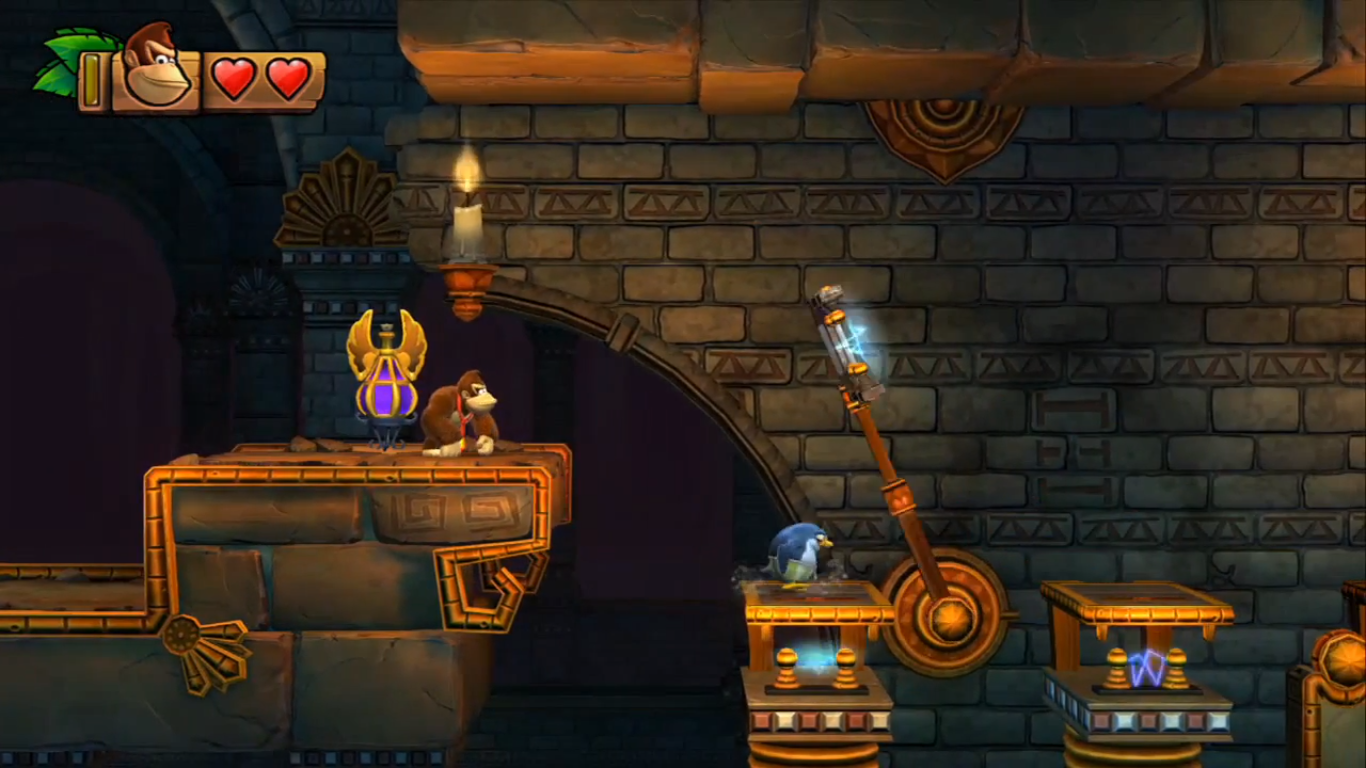

This makes the spin attack more challenging to pull off, but subsequently it feels a little more satisfying to use than a simple jump attack. Unlike falling on a baddie from above, using a spin requires knowing how much time you spend in the spin animation before breaking out into a run, as otherwise you’ll instead run into the enemy (and thus take damage and lose the Kong you control). The spin move is also usable as an attack, careening into enemies to knock them away. Since jumping on enemies is a core part of the game, adding elements like this to increase the fun factor goes a long way to making the game feel good to play. Jumping as you land on top of an enemy provides a boost to your jump height, which adds to the thrill of the action. As discussed before, this is used in some places as the required means of progressing through the level, but it’s also included in less critical areas as a fun thing to do. Stompable enemies are sometimes placed in such a way that you can chain jumping on multiple of them in a row. I use the term “hurtbox” to mean the collision area where contact results in hurting the entity possessing it. For example, Sneeks and Flitters have quite wide hurtboxes (and they are visually long-looking characters to communicate this), making them relatively easy to land on other foes, like the Klomp, stand upright and present a smaller hurtbox, and thus are more of a challenge to land on precisely. That doesn’t mean all stompable enemies are the same there’s plenty of variety to enemy widths, which affects how easy it is to land within their hurtbox. It’s usually pretty obvious which foes can be stomped they lack any sort of visible protection to their heads which might discourage you from jumping upon them. Stomp EnemiesĪs is true in many platforming games, there are many baddies which can be defeated by jumping on their heads and knocking them off the stage I’ll call this “stomping”. Some specifically protect themselves against particular kinds of moves, forcing you to be more strategic about how you approach them. Many of the baddies are designed to be beaten with one or more of the regular moves in the Kongs’ arsenal. This approaches helps us focus on what moves you need to employ to defeat a baddie, which makes it well-suited for this design dive. That isn’t wrong at all, but I want to approach this from a different perspective I want to examine enemies by how they are designed to be defeated. When asked about what kinds of enemies are present in Donkey Kong Country 2, one might say “there’s some ground enemies, flying enemies, swimming enemies, some bosses”. We’ll review the types of enemies that get included in the game, relative to how you are expected to deal with them next, we’ll examine a few foes that implement some special mechanics on top of their base type finally, we’ll look at a few levels to see how enemies are placed to take advantage of the Kongs’ movement, their movement, and the level’s design to create compelling, challenging gameplay experiences. Now, we’ll look at the final segment of the movement equation: the foes the Kongs must fight throughout the levels. In the first part of this blog series, we looked at the many abilities and forms of movement the Kongs can do in the second part, we examined the design of the levels those actions are performed in, and how it compliments them. As is undoubtedly true for many games, it is the whole package together which creates that feel I love so much. It’s not just a matter of analyzing the actions and movements in and of themselves, however the level and enemy design of DKC2 are intentionally crafted to augment those basic and special actions. To answer that question, I’ll take a close look at the action verbs DKC2 employs related to the player characters. As a game designer, I found myself wondering: what is it, exactly, that makes me love DKC2’s movement so much? Never do I feel as though I can’t adequately control Diddy or Dixie Kong as I navigate them through many levels of perilous adventure. One of the reasons, among many, why is the game’s character movement feels almost perfect.

Check out all the parts here!Īs a child, I loved to play Donkey Kong Country 2: Diddy’s Kong Quest as an adult in my early thirties, I still love playing it.


 0 kommentar(er)
0 kommentar(er)
